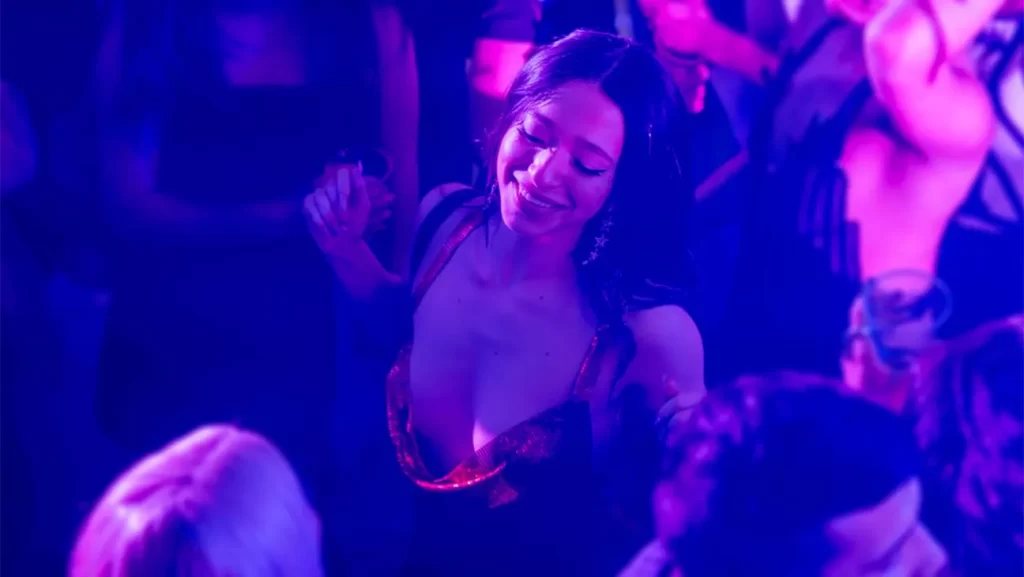Clothes, hair, and makeup tell stories not just about characters with monster prosthetics or gushing blood wounds, but tales of classism, beauty, and objectification shine through the actors’ hair and makeup, as well as their costume choices, or rather, the hair & makeup artists and the costume designers behind them.
In Sean Baker’s Anora, there seems to be nonstop controversy yet again about his depiction of, as Gabriel García Márquez would describe in Memoirs of My Melancholy Whores, “beautiful, melancholy sex workers,” But what everyone agrees on is how stunning and vibrant Ani (Mikey Madison) is on screen. Every element of Anora, from set design and cinematography to hair, makeup, and costumes, complements the story, elevating it to greatness on a small-scale film, as one would expect with Baker’s filmography.
Ani’s costumes vary from one stage of her life to the other. The film’s costume designer Jocelyn Pierce summarizes it perfectly during Ani’s clubbing days with hair tinsel and body diamond dust glitter to her clothes on her trip returning home with a puffer jacket and Uggs. Then comes her stunning Hervé Léger dress as she first enters the magical world that is Ivan’s (Mark Eydelshteyn) house and extravagant life, then her floor-length fur coat, and her (3-carat) wedding ring. Anora tells a rags-to-riches story through hair, makeup, and costumes about a too-ambitious young woman and how her brief brush with the upper class and a snooty Ogliarchs led to her fall from grace.
Anora’s classist commentary speaks volumes, from the electric blue dress Ani picks for her first private date with Ivan to her excessive Carrie Bradshaw-like shopping spree, buying from high-end luxury brands the moment she becomes his wife, to the way she picks up her fur coat, the red scarf, and high heels on the hunt for him with his godfather’s henchmen, including the dutiful Igor (Yura Borisov), whose style is representative of his status —a handsome young man, born into poverty and a life of crime, hiding in the shadows, with glimpses of his manly beauty escaping from underneath the hoodie.
But from New York, the mood shifts, and we move to a colorful, bloody, and mascara-smeared Mexico with Jacques Audiard’s Emilia Pérez, where three ladies find their place in a merciless world. But what role do costumes play in this movie? How do they speak of the characters’ suffering? Most of the ladies’ costumes, especially on their fancy nights and luxurious dining outings, are from the Saint Laurent archives, so again, high-end fashion speaks volumes.

Whether it’s Zoe Saldaña’s red suit, Selena Gomez’s printed Saint Laurent blazer, or Karla Sofía Gascón’s entire wardrobe, those women seek identity and self-expression, and what better way to do that than through fashion and styling? Saint Laurent is bold, visible, and skin-baring in so many ways. Gomez’s blouse, which she opens to show her breasts to her lover as she gets out of the car to say goodbye to him, is a testament to the fragile relationship the famed fashion house has with femininity, and this is visible throughout the movie.
Gascón’s dresses are bodycon, form-fitting, and almost hugging her voluptuous figure. In her portrayal of Emilia, she breathes through her clothes; her first meeting with Saldaña’s character in that restaurant in London showcases an elegant lady in black with a fashion choice, smart and classic, one that can never go wrong. Her makeup, as orchestrated by makeup department head Julia Floch Carbonel and SFX makeup artist Jean Christophe Spadaccini, shifted from her pre-transition prosthetics to become Manitas, to soft tones and naturalistic look to accentuate Gascón’s beautiful skin and strong features as she played Emilia.
In both films, it’s easy to see a culture of excess, a cocktail of colors, fabrics, and branded items that only confess to a lifetime of poverty, suddenly followed by a plunge into riches. Those women have been thrust into the upper-class world with all its shady, dark interwebs, and now they have to dress the part. Whether a trophy wife to a Russian bratty heir in Anora, the gang girl in Emilia Pérez, or the woman who travels her way to the top by taking over a drug lord’s shady business, all those women run in circles of uncertainty, using costumes as armor to shield them from an indecisive world marked by the rise and fall of the bourgeois and those who accompany them on their life-or-death journeys.






